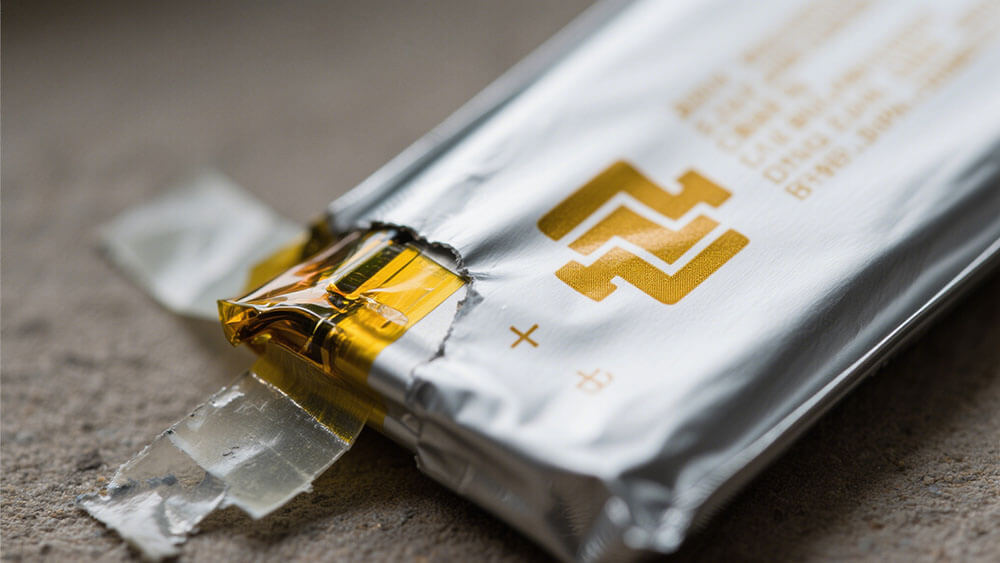
Solid-state batteries represent a technological leap in energy storage. Unlike traditional lithium-ion batteries, they use a solid electrolyte, which enhances both safety and performance.
These batteries offer significant advantages:
Up to 350 Wh/kg energy density, far surpassing lithium-ion batteries.
Safety risks reduced by as much as 90%, minimizing thermal runaway incidents.
Their durability is equally impressive. For instance, QuantumScape’s solid-state battery retained over 90% capacity after 1,000 cycles at 30°C. This makes them an ideal choice for electric vehicles and large-scale energy storage systems, where efficiency and reliability are paramount.
Key Takeaways
Solid-state batteries use solid materials for electrolytes. This makes them safer and better than regular lithium-ion batteries.
They store more energy, reaching up to 500 Wh/kg. This makes them great for electric cars and gadgets.
These batteries last longer, keeping over 80% power after 500 uses. They are strong and dependable.
Part 1: What Are Solid-State Batteries?

1.1 How Solid-State Batteries Work
Solid-state batteries operate on a principle similar to traditional lithium-ion batteries but with a critical difference: they use a solid electrolyte instead of a liquid one. This solid electrolyte facilitates the movement of lithium ions between the anode and cathode during charging and discharging cycles.
The solid electrolyte can be made from various materials, including ceramics, sulfides, and polymers. These materials act as ion conductors, enabling efficient energy transfer while maintaining structural stability. Unlike liquid electrolytes, solid electrolytes eliminate the risk of leakage and significantly reduce the chances of thermal runaway.
Recent advancements in battery research and innovation have introduced silicon-based all-solid-state batteries. These batteries feature a Li21Si5/Si–Li21Si5 double-layered anode, which enhances ionic and electronic conduction without requiring external pressure. Laboratory tests have demonstrated impressive performance metrics, such as a critical current density of 10 mA/cm² at 45°C and a capacity of 10 mAh/cm².
Key Insight: The use of solid ion conductors in solid-state batteries not only improves safety but also boosts energy density, making them a promising solution for applications like electric vehicles and consumer electronics.
1.2 Key Features and Advantages
Solid-state batteries offer several advantages over conventional lithium-ion batteries, making them a game-changer in battery technology.
1. Enhanced Safety
Solid-state batteries significantly reduce the risk of thermal runaway.
Heat generation during thermal runaway is only 20-30% of that in conventional batteries.
However, safety concerns remain under short-circuit conditions, as larger temperature increases have been observed compared to traditional batteries.
2. Higher Energy Density
These batteries achieve energy densities of 300-500 Wh/kg, far exceeding the 160-270 Wh/kg range of NMC lithium batteries.
The use of solid electrolytes allows for thinner and more compact designs, increasing the energy storage capacity.
3. Wider Operating Temperature Range
Solid-state batteries can function efficiently between -20°C and 80°C.
This wide range makes them suitable for industrial applications and extreme environments.
4. Faster Charging Speeds
Faster ion transfer within the solid electrolyte reduces charging times.
A pure silicon anode in solid-state batteries has demonstrated a high current density of up to 5 mA/cm², enabling rapid charging.
5. Longevity and Durability
Solid-state batteries retain 80% of their capacity after 500 cycles at 5 mA/cm².
Their low expansion rate (14.5% after 1,000 cycles) ensures long-term stability.
Feature | Metric/Result |
|---|---|
Safety | Reduced risk of thermal runaway; heat generation during thermal runaway is 20-30% of conventional batteries. |
Operating Temperature Range | Can operate above 60°C; traditional batteries operate from -20°C to 60°C. |
Voltage | Can exceed 5 V; traditional lithium-ion batteries cannot exceed 4.5 V. |
Charging Speed | Faster ion transfer reduces charging times compared to lithium-ion batteries. |
Capacity Retention | 80% capacity retention after 500 cycles at 5 mA/cm² for μSi all-solid-state battery. |
These features make solid-state batteries a preferred choice for electric vehicles, where safety, energy density, and fast charging are critical. They also hold immense potential for consumer electronics, industrial applications, and infrastructure projects.
Pro Tip: If you’re considering custom battery solutions for your business, explore options tailored to your needs at Large Power.
Part 2: Historical Development of Solid-State Batteries

2.1 Early Discoveries and Theoretical Foundations
Solid-state batteries trace their origins to the mid-20th century when researchers began exploring alternatives to liquid electrolytes. Early studies focused on solid ionic conductors, such as silver iodide and sodium beta-alumina, which demonstrated the potential for efficient ion transport. These discoveries laid the theoretical groundwork for modern solid-state battery technology.
The concept of using solid electrolytes gained traction due to their ability to address safety concerns associated with liquid electrolytes. By eliminating the risk of leakage and flammability, solid-state batteries promised a safer and more durable energy storage solution. However, early prototypes faced challenges, including low ionic conductivity and high manufacturing costs, which limited their practical applications.
Note: The foundational research in solid-state batteries paved the way for innovations that would later revolutionize energy storage systems, particularly in electric vehicles and consumer electronics.
2.2 Key Milestones in Solid-State Battery Technology
Over the decades, solid-state battery technology has achieved significant milestones, driven by advancements in materials science and manufacturing techniques. These milestones highlight the progress made in overcoming technical barriers and achieving commercial viability.
Year | Milestone Description |
|---|---|
2024 | Solid-state batteries represent a significant technological leap forward, offering numerous advantages over traditional lithium-ion batteries. Companies like Toyota, Ford, and QuantumScape are heavily invested in their development. |
In addition to timeline-based achievements, quantitative milestones have also shaped the evolution of solid-state batteries:
Milestone Type | Achievement/Details |
|---|---|
Cycle Life | Tesla: 1000-2000 cycles; Solid Power: lower end; QSE-5: upper end |
Charge Time | Solid state batteries: 15 minutes; Tesla: 15-25 minutes (not recommended) |
Commercialization | QuantumScape: preparing for 2025; Solid Power: predicts 2028 for regular EV use |
These milestones reflect the growing interest and investment in solid-state batteries, particularly from automotive giants and battery manufacturers. As you can see, the technology is steadily moving toward large-scale adoption, with promising implications for industries like transportation and infrastructure.
2.3 Recent Advancements and Industry Adoption
Recent years have witnessed remarkable advancements in solid-state battery technology. Innovations in solid electrolytes, such as sulfides and ceramics, have improved ionic conductivity and reduced production costs. Companies like QuantumScape and Solid Power have introduced prototypes with higher energy densities and faster charging capabilities, addressing key limitations of lithium-ion batteries.
Industry adoption has also accelerated, driven by the demand for safer and more efficient energy solutions. Solid-state batteries now hold a dominant position in consumer electronics, accounting for 32.9% of the market share. Their compact design and high energy density make them ideal for devices like smartphones and wearables.
The electric vehicle segment has experienced rapid growth, with a compound annual growth rate (CAGR) of 64.2%. Governments worldwide are implementing policies to promote sustainable transportation, further boosting the adoption of solid-state batteries.
Pro Tip: If your business operates in sectors like consumer electronics or industrial applications, consider exploring custom solid-state battery solutions tailored to your needs at Large Power.
Part 3: Solid-State Batteries and the Lithium-Ion Ecosystem

3.1 Challenges in Transitioning from Lithium-Ion to Solid-State
Transitioning from lithium-ion batteries to solid-state batteries presents several challenges that you must consider during the development process. While solid-state batteries promise higher energy density and improved safety, their adoption faces hurdles in manufacturing scalability, cost, and material compatibility.
1. Manufacturing Complexity
Solid-state batteries require advanced production techniques to integrate solid electrolytes seamlessly. Unlike lithium-ion batteries, which rely on liquid electrolytes, solid-state designs demand precise engineering to ensure ionic conductivity and structural stability. Scaling these processes for mass production remains a significant obstacle.
2. Material Limitations
The compatibility of solid electrolytes with existing electrode materials poses another challenge. For instance, lithium dendrite formation can compromise the battery’s performance and safety. Research into stable solid electrolytes, such as sulfides and ceramics, is ongoing, but achieving consistent results across various applications is difficult.
3. Cost Barriers
Solid-state batteries are more expensive to produce than lithium-ion batteries due to the high cost of materials and specialized manufacturing equipment. This cost disparity limits their immediate adoption in industries like consumer electronics and transportation.
Tip: If your business is exploring solid-state battery solutions, consider consulting experts to address these challenges effectively at Large Power.
3.2 Future Trends and Innovations in Solid-State Batteries
The next generation of batteries, particularly solid-state designs, is poised to revolutionize energy storage. Market research highlights several trends and innovations that will shape the future of this technology:
Enhanced Energy Density: Solid-state batteries offer energy densities of 300-500 Wh/kg, making electric vehicles cheaper and more efficient.
Safety Improvements: Stable solid electrolytes at room temperature reduce risks associated with thermal runaway.
Cost Efficiency: Research investments by companies like Panasonic and Samsung SDI aim to lower production costs.
Renewable Energy Integration: Solid-state batteries provide efficient storage solutions for solar and wind energy, supporting global carbon reduction pledges.
Market Growth: Electric car sales increased by 40% from 2019 to 2021, reflecting strong demand for advanced battery technologies.
These advancements align with the growing need for sustainable energy solutions. Solid-state batteries are expected to dominate sectors like transportation, infrastructure, and industrial applications. As governments worldwide implement policies to reduce carbon emissions, the demand for efficient energy storage systems will continue to rise.
Pro Tip: Stay ahead of the curve by exploring custom solid-state battery solutions tailored to your industry needs at Large Power.
Solid-state batteries redefine energy storage with their enhanced safety, higher energy density, and longer lifespan.
Key Advantages:
Lower material costs
Higher theoretical capacity
Improved safety features
Advantage | Description |
|---|---|
Enhanced Safety | Greater thermal stability and reduced fire risks. |
Higher Energy Density | Enables longer EV ranges and compact designs. |
Longer Life | Outlasts traditional lithium-ion batteries. |
Their evolution, from theoretical foundations to modern breakthroughs, underscores their transformative role in electric vehicles and renewable energy systems. With advancements addressing manufacturing challenges, these batteries promise a sustainable future for energy storage.
FAQ
1. What industries benefit the most from solid-state batteries?
Solid-state batteries excel in electric vehicles, consumer electronics, and medical devices due to their high energy density and safety.
2. How do solid-state batteries compare to lithium-ion batteries?
Solid-state batteries offer higher energy density (300-500 Wh/kg) and improved safety. However, lithium-ion batteries remain more cost-effective for large-scale production.
3. Can solid-state batteries support industrial applications?
Yes, their durability and wide temperature range make them ideal for industrial use, including robotics and infrastructure.
Pro Tip: For tailored battery solutions, consult Large Power experts.






